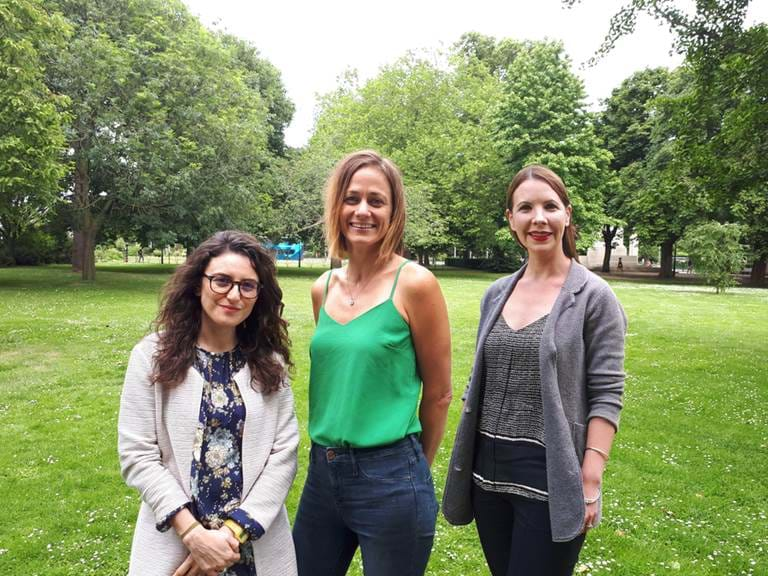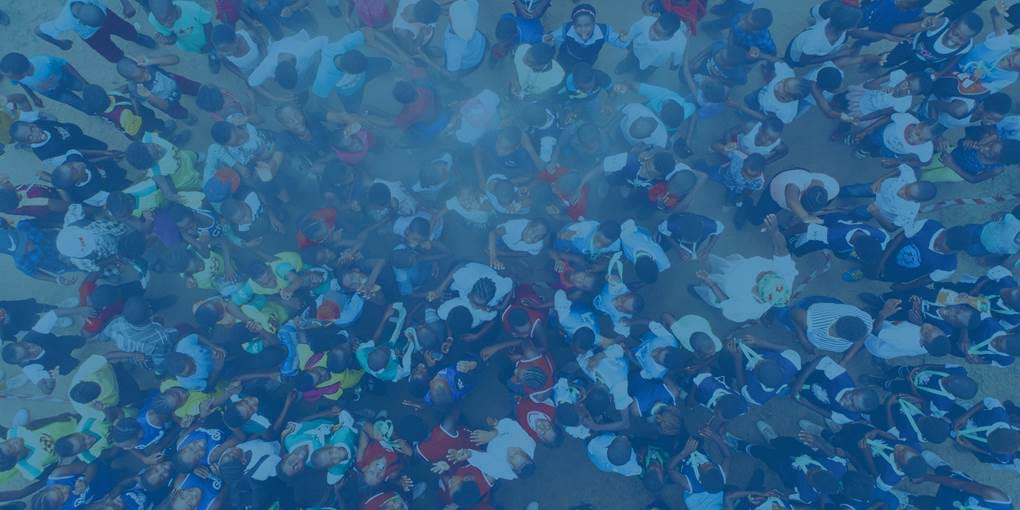World Population Day is a day to focus attention on the urgency and importance of population issues. This year marks the 25th anniversary of the 1994 International Conference on Population and Development, which recognised that reproductive health and gender equality are essential for achieving sustainable development.
On World Population Day 2019, Flowminder and WorldPop staff highlight how some of their projects are contributing to this area of work.

Dr Samantha Watson (SW), right, is a Senior Research Associate at the Flowminder Foundation. Dr Natalia Tejedor Garavito (NTG), left, and Dr Kristine Nilsen (KN), centre, are WorldPop researchers at the University of Southampton.
Can you give us a brief introduction about your research / project?
SW: Flowminder is leading a research project called “High-resolution gender-disaggregated dynamic mapping study”. The study combines nationally representative survey data with satellite imagery and mobile phone data to map spatial variation in men’s and women’s literacy, employment, and health outcomes across Nepal - information which is currently limited at the subnational level. In a second workstream we assess the scope for gender to be predicted from behavioural traces found in anonymised mobile phone data. The goal here is to uncover gender based differences in mobility patterns and trajectories - phenomena that are very difficult to measure using traditional research tools. Both work-streams are intended to produce new evidence - at previously unavailable spatial and temporal levels of detail - to inform equitable resource allocation and service delivery decisions within Nepal.
KN: Every day 830 women die from causes related to pregnancy and childbirth. The large majority of these deaths occurs in low- and middle-income countries and most of them could have been prevented if women had access to quality maternal health services. A key challenge to improve maternal health is the availability of data. Our research estimates and maps inequalities in the use of maternal health services at high spatial resolutions to identify geographical areas within countries where access to services is low. However, ensuring equitable access and use of the services is not enough, we need more information on what is going on inside the health facilities to assess if the services women receive are of sufficient quality. We’re therefore increasingly working with integrating different types of data sources to get a better understanding of who is receiving what maternal health services where.
NTG: I lead a project to produce freely available high-resolution maps of women of childbearing age, pregnancies and births, for countries in Africa, Asia, Latin America and the Caribbean. Additionally, WorldPop works on estimating the travel time to health facilities to estimate the proportion of pregnant women who live in remote areas in Sub-Saharan Africa and the Pacific Region.
The 2019 theme for World Population Day is about gender equality and reproductive health. How is your project contributing to this topic?
SW: Within our current study, we’re clear that sex-disaggregated data on spatial sex and gender-based inequities are a necessary but not sufficient condition for gender-equitable development and health outcomes. That’s why we combine a mixed methods research approach with workstreams to develop and deliver training programmes in gender-based analysis to support the development of policies that assess, address, and respond to local level barriers to gender equitable development. Genuine and meaningful in-country partnerships are make or break in impact focussed research and this project promotes this style of working.
KN: Gender inequality and discrimination limits women’s reproductive rights. For example, gender norms and harmful traditions and practices poses great risk to women’s reproductive health. Adolescence is a time in a woman’s life where she is particularly vulnerable. Every year, 1 million girls under the age of 15 years give birth and we know that young girls are particularly at risk of complications associated with pregnancy and childbirth. Working in collaboration with the Department of Demography and Social Statistics, WorldPop recently bid to become part of a project where the goal is to ensure that adolescent girls and boys have access to comprehensive sexual education and youth friendly reproductive health services.
NTG: The datasets I have been working on represent a step forward in the investigation of births and pregnancies at sub-national level: they are vital to inform policy formulation, planning, monitoring and evaluating health indicators. They are especially important in lower income countries where infectious diseases are a major concern for pregnant women and newborns, as highlighted by the recent Zika virus epidemic. Additionally, WorldPop provides valuable information for policymakers to target their efforts effectively to improve transport infrastructure and healthcare provision, as quick access to emergency care can be a matter of life or death for mothers and their children.
Why do you think it’s important to focus on, and increase efforts towards, achieving gender equality and reproductive health and rights?
SW: So honestly, this question made me pause - and I’m grateful to you for making me reflect on my own assumptions and starting points. My background - as a statistician and mixed methods researcher focused for many years on the political economy of development in South Asia - means that I sometimes take the importance of an -intersectional- ‘gender lens’ for granted. Here, I want to be clear and state that when I say gender, I don’t mean ‘women’ - I mean gender as an (individually internalised) social relation - one which has profound implications in terms of the opportunities and life chances available to everyone everywhere.
KN: The Plan of Action from the International Conference on Population and Development in 1994 affirmed women’s reproductive rights. For women to be able to exercise these rights, they need access to high-quality family planning services, abortion services and maternal health services to mention a few. Currently many women in low- and middle-income countries die unnecessarily while giving birth and these women could have survived if they had received the health services that many of us take for granted.
NTG: Everyone should have access to reproductive health care, and having women at the centre of policies related to this topic closes inequality gaps such as in mortality and coverage of services for maternal and newborn care.
Why did you decide to focus your research on this topic? What do you like most about working on this project?
SW: For me, this study is an important opportunity to unpack and assess the dimensions of gender that may be amenable to capture in and through large scale digital data, and those that may be hidden or obscured. The study’s point of departure is that gender is multi-faceted. Simultaneously a dimension of social structure, a discursive-symbolic formation, and a feature of individual self / identity - historically and culturally (re)constituted and cut through by geography, social class, race, ethnicity, and age/life stage. This study has been an opportunity to work with an international team of researchers, practitioners and policy-makers - to combine novel and traditional data sources, innovative analytical methods, and substantive and area expertise - in order to progress the emerging field of novel data analytics for sustainable and equitable development.
KN: I decided to use my skills as a statistician to work on universal access to maternal health services because I believe in the reproductive rights of every woman. Most maternal deaths could have been prevented if women had access to quality emergency obstetric care provided by a skilled health worker.
NTG: Back in 2016, when there was a Zika outbreak, pregnant women and newborns were at the centre of the spread of the disease, however no accurate data was available to estimate the number of potentially affected population, and most importantly in those developing countries that were most at risk of the spread of the disease. So, WorldPop initiated this project to focus our research to produce detailed maps for these specific demographic groups. Our research is vital to improving the livelihood of women in developing countries, providing accurate information for policymakers to address specific issues related to reproductive health.
Flowminder and WorldPop at the University of Southampton work closely together to develop new methods and data to understand the distributions, characteristics and dynamics of human populations. WorldPop/Flowminder support governments and organisations to incorporate new analytical methods in their work and to improve decision making using data and tools.
